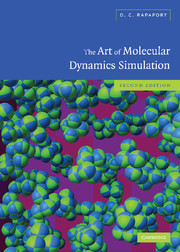Book contents
- Frontmatter
- Contents
- Preface to the first edition
- Preface to the second edition
- About the software
- 1 Introduction
- 2 Basic molecular dynamics
- 3 Simulating simple systems
- 4 Equilibrium properties of simple fluids
- 5 Dynamical properties of simple fluids
- 6 Alternative ensembles
- 7 Nonequilibrium dynamics
- 8 Rigid molecules
- 9 Flexible molecules
- 10 Geometrically constrained molecules
- 11 Internal coordinates
- 12 Many-body interactions
- 13 Long-range interactions
- 14 Step potentials
- 15 Time-dependent phenomena
- 16 Granular dynamics
- 17 Algorithms for supercomputers
- 18 More about software
- 19 The future
- Appendix
- References
- Function index
- Index
- Colophon
9 - Flexible molecules
Published online by Cambridge University Press: 28 February 2011
- Frontmatter
- Contents
- Preface to the first edition
- Preface to the second edition
- About the software
- 1 Introduction
- 2 Basic molecular dynamics
- 3 Simulating simple systems
- 4 Equilibrium properties of simple fluids
- 5 Dynamical properties of simple fluids
- 6 Alternative ensembles
- 7 Nonequilibrium dynamics
- 8 Rigid molecules
- 9 Flexible molecules
- 10 Geometrically constrained molecules
- 11 Internal coordinates
- 12 Many-body interactions
- 13 Long-range interactions
- 14 Step potentials
- 15 Time-dependent phenomena
- 16 Granular dynamics
- 17 Algorithms for supercomputers
- 18 More about software
- 19 The future
- Appendix
- References
- Function index
- Index
- Colophon
Summary
Introduction
The rigid molecule approach described in Chapter 8 is limited in its applicability, because it is really only appropriate for small, compact molecules. Here we consider the opposite extreme, namely, completely flexible molecules of a type used in certain kinds of polymer studies. No new principles are involved, since the intramolecular forces that maintain structural integrity by holding the molecule together, as well as providing any other necessary internal interactions, are treated in the same way as intermolecular forces. Later, in Chapters 10 and 11, we will consider more complex models, in which molecules exhibit a certain amount of flexibility but are also subject to various structural constraints that restrict the internal motion. The first case study in this chapter deals with the configurational properties of a single chain molecule in solution. The second deals with a model of a surfactant in solution, in which very short, interacting chain molecules are just one of the components of a three-component fluid; this very simple system is capable of producing coherent structures on length scales greatly exceeding the molecular size, as the results will demonstrate.
Description of molecule
Polymer chains
Owing to the central role played by polymers in a variety of fields, biochemistry and materials science are just two examples, model polymer systems have been the subject of extensive study, both by MD and by other methods such as Monte Carlo [bin95].
- Type
- Chapter
- Information
- The Art of Molecular Dynamics Simulation , pp. 245 - 266Publisher: Cambridge University PressPrint publication year: 2004
- 1
- Cited by



